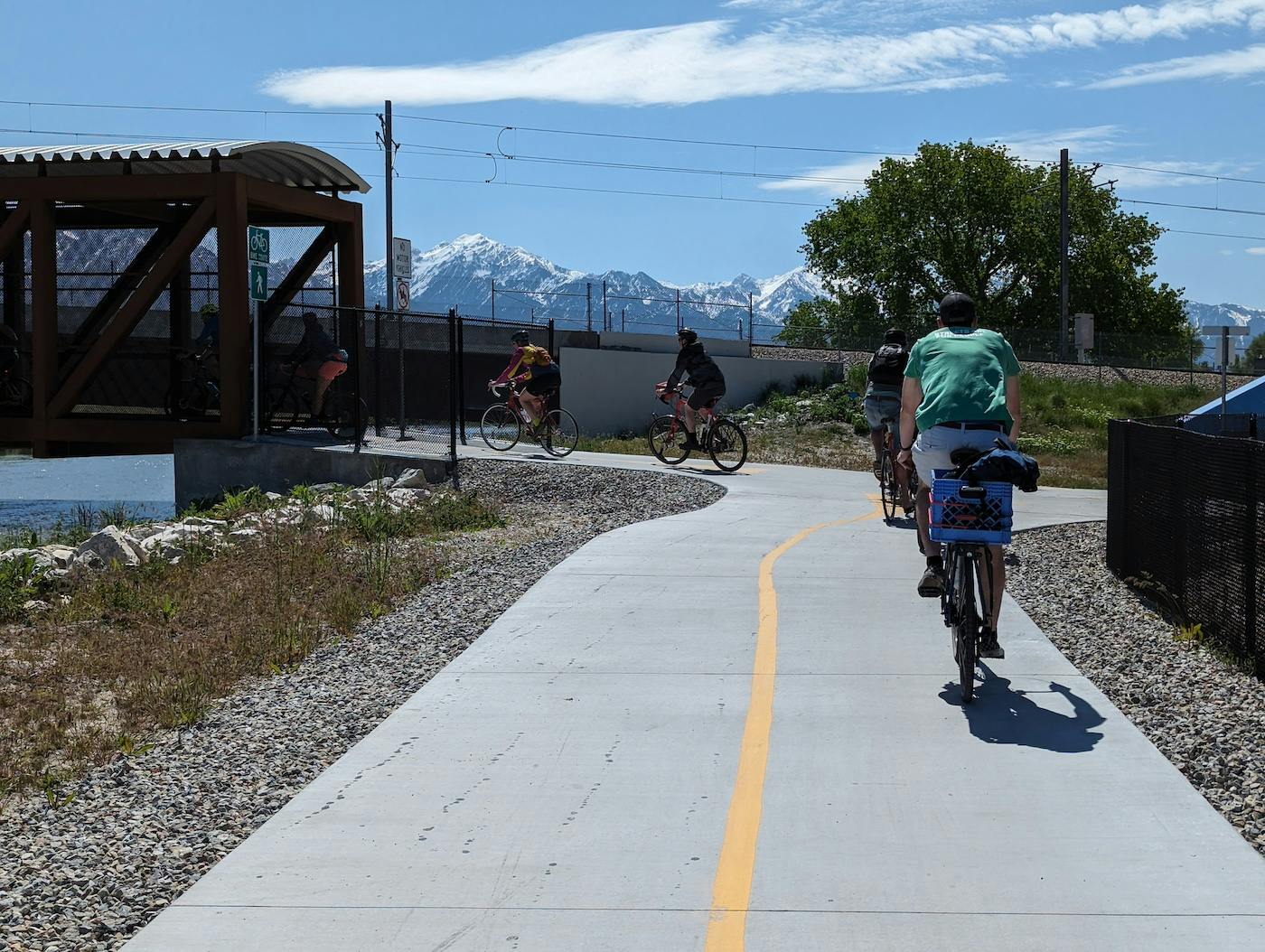Investments in Infrastructure and Community Make Salt Lake City a Great Place to Bike
By: Jack Foersterling, editorial content manager

One of our 2024 Cities on the Rise, the Utah capital city raised its City Ratings score from 46 in 2020 to 52 in 2024.
Bicyclists enjoy Salt Lake City's Jordan River Trail where the newly completed Parley's Trail provides a safe freeway crossing for the east and west side of the city. Photo Credit: Sweet Streets
With the release of our seventh annual City Ratings, featuring 2,300 U.S. cities for 2024, PeopleForBikes is celebrating cities that put in the dedicated work in recent years to improve their score and make biking better in their communities.
Salt Lake City is one of our 2024 Cities on the Rise, raising their score from 46 (out of a possible 100) in 2020 to 52 in this year’s ratings. Our research shows that a score of 50 is the tipping point to becoming a great place to bike for most cities, and Salt Lake City is proof that when the right investments are made, bicycling becomes better for everyone.
“We’re really starting to fill out our street network,” says Troy Saltiel, an executive board member of Sweet Streets, a local group that educates and advocates for people-first planning and safe mobility options for people of all ages, abilities, and incomes. “Our streets are large, which is hard, but we’re putting in more bike lanes as streets are repaved. We’re also filling out our neighborhood byways, greenways, and bike boulevards that all fit into our network.”
Saltiel points to one project in particular as a major recent win for the city — the 9 Line Trail. Built along an abandoned railway line, the off-street, multi-use path stretches from the west to east side of the city parallel to the 900 South thoroughfare and connects numerous neighborhoods, giving residents a safe option for traveling by foot or bike as well as an accessible recreation corridor.

The 9 Line Trail along Liberty Park, where it crosses 700 E, an urban highway. Photo Credit: Sweet Streets
In the fall of 2023, Salt Lake City also celebrated the completion of one of its most significant public works projects to date — the 300 West Reconstruction Project — which was named one of PeopleForBikes’ Best New Bike Lanes of 2023. The project features a separated, two-way, 10-foot-wide bike lane; upgraded sidewalks; and more than 200 new trees to provide shade and serve as a buffer between people on bikes and the roadway.
Both of these infrastructure projects complement the city’s Pedestrian and Bicycle Master Plan, which was approved by the Salt Lake City Council in 2015. The plan outlines Salt Lake City’s impressive goal of expanding its network to include 220 miles of bikeways by 2035. While that may seem like a heavy financial lift for the city, the plan states its bike network expansion can be built for the same amount of money as widening just 1.3 miles of freeway.
Saltiel also says infrastructure improvements aren’t the only work being done to improve bicycling in Salt Lake City. Sweet Streets played a major role in advocating for the city’s “20 is Plenty” campaign, which successfully pushed the city council to pass an ordinance lowering speed limits on 70% of city streets from 25 to 20 miles per hour.
When asked what advice he had for other cities looking to improve biking on their streets, Saltiel’s answer was simple — get involved in the community.
“You need to get out and know your community and bring that community together,” he says. “Get people comfortable on bikes and give people a place to gather and create a low barrier to entry.”
Bicycle Collective, a statewide nonprofit organization, is doing just that for residents of Salt Lake City.
“We’re what we call a ‘do it yourself with help’ shop,” says Thomas Cooke, a digital strategist for the community-based bike shop that offers tools and workbenches for residents to work on their own bikes. “Annual memberships are $100 with unlimited bench time and for non-members, bench time is $5 an hour. We have professional mechanics on hand that are there to help as well as refurbish donated bikes that are either resold at affordable prices or given to those in need.”
Bicycle Collective recently celebrated the grand opening of their new shop space, conveniently located at the intersection of the 300 West separated bike lane and the 9 Line Trail, allowing community members to easily access the space by bike.
“We have four shops in Utah, and our Salt Lake City one is in an 18,000 square foot building. Our old one was only 3,000 square feet,” says Cooke. “With the ability to receive more bikes and work on more bikes, we can do more for the community. Last year we gave away 1,349 bikes through local partners and sold about 1,500, with the average price under $300.”
Looking ahead, Saltiel says Salt Lake City looks to begin work on its Green Loop — a greenway/park multimodal space that encircles the city’s downtown hub. Wide, five-lane streets will be reduced down to two lanes with the rest of the space converted to park space with other amenities like bike lanes that go all the way around the city. To no surprise, the community aspect will play a large role in the project.
“Sweet Streets isn’t just about walking and biking, we’re about community,” says Saltiel. “We’re not just here to install a bike lane, we want to see the community out enjoying their public spaces, and streets are public spaces.”
Related Topics:
